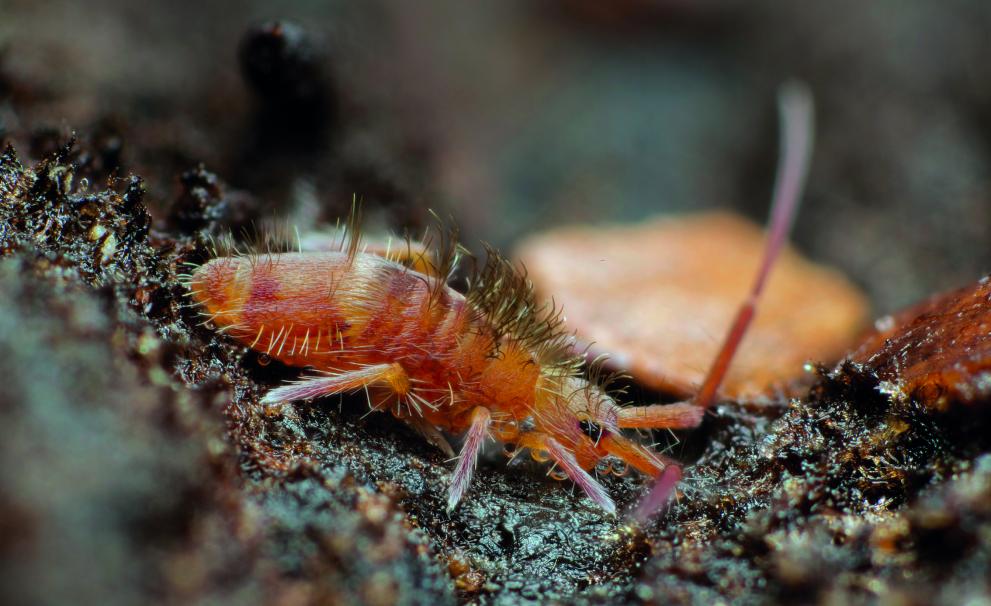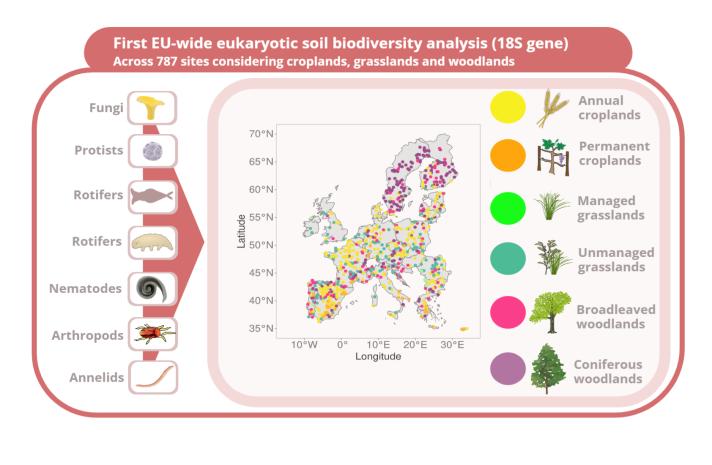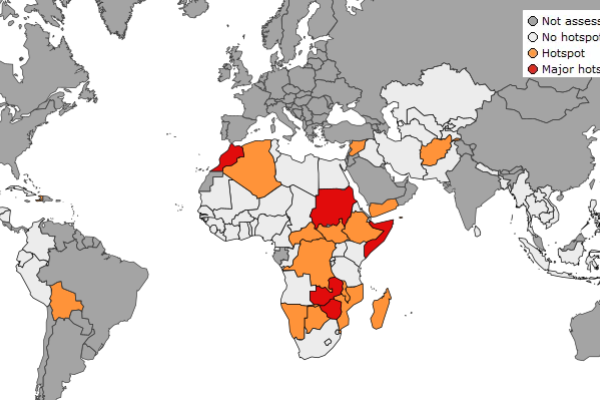
Little is known about the organisms that live in our soils. In recent years, DNA analyses have helped to better understand soil life. However, the majority of studies focused on microbial communities (bacteria and fungi). A first-ever continent-wide DNA-analysis investigated the diversity of soil eukaryotes. Soil life comprises prokaryotes (bacteria and archaea) and eukaryotes (fungi, protists, rotifers, tardigrades, nematodes, arthropods and earthworms).
The study, Ecosystem type drives eukaryotic soil biodiversity across Europe, carried out by JRC soil and partner scientists, aimed to identify the drivers behind soil eukaryotic diversity by investigating (among others) soil properties, climate and ecosystem type. The study considered sites ranging from croplands, managed and unmanaged grasslands and coniferous and broad-leaved woodlands.
Why soil life is the foundation of all terrestrial life
There has been a growing recognition of the crucial role played by soil biodiversity in maintaining the ecosystem services. Prokaryotes (bacteria and archaea) and eukaryotes (fungi, protists, rotifers, tardigrades, nematodes, arthropods and earthworms) form a complex and dynamic network.
They provide crucial ecosystem services, building the foundation for terrestrial life. For example, they decompose organic material, provide antibiotics, and allow soils to filter and store water. They play a particularly critical role in agriculture. Soil organisms provide nutrients to plants and enhance the plants' resilience to stressors.
For example, they suppress soil-borne pathogens and pests. Despite their importance, knowledge on soil life remains limited.
More knowledge is needed on soil life
For the past decades, molecular analysis of DNA has helped reveal the hidden realm of soil life. Soils are among the most diverse habitats on Earth. They are teeming with a diverse array of organisms, ranging from microorganisms (bacteria, fungi and protists) and microfauna (rotifers, nematodes and tardigrades), to mesofauna (mites, collembola and enchytraeids) and macrofauna (earthworms and larger insects), up to megafauna, including mice and moles (Orgiazzi et al., 2016).
However, the heterogeneous nature of soil life makes it difficult to comprehend the distribution patterns of soil organisms, especially at large, continental scale. Understanding the relationships between soil life and its environment is crucial for maintaining healthy soils.
Currently, there is no baseline for soil organisms that is comparable to above-ground organisms. Only known organisms can be monitored and integrated into conservation activities, like being included in a “red” list. Therefore, missing baselines prevent conservation activities.
Ecosystem type driving the diversity
In this context, the JRC-led study finds the ecosystem type to be the dominant driver of eukaryotic diversity. The findings also show that soil properties are more influential than climatic variables. Long-term variables for climate and land-use were found to be more important than variables measured over the sampling month.
The study was published in Global Change Biology by the JRC’s Soil Team and partner scientists, mainly from the University of Vigo, in the framework of JRC’s initiative Collaborative Doctoral Partnership.
Greatest diversity in croplands as a legacy effect of past land uses
Surprisingly, croplands exhibited greater biodiversity despite intensive land use. Croplands were also more homogeneous compared to the composition of other ecosystems. High numbers of taxa of eukaryotic groups overlapped in croplands, grasslands and woodlands. For the majority of the groups, croplands hosted the most unique taxa.
The study proposes a possible explanation for the greater diversity detected in agricultural areas. In recent decades, many grasslands and woodlands across the European were converted into croplands. The high diversity observed in croplands and the great proportion of overlapping taxa between ecosystems might reflect DNA accumulation from previous land uses.
The higher soil biodiversity in croplands could be a legacy effect from the DNA of dormant or dead organisms. This might also explain why long-term variables for land use and climate were more relevant compared to monthly variables.
The way forward: learnings for future monitoring activities
The study provides a first baseline of soil eukaryotes and their drivers to inform future monitoring activities. It also reveals methodological limitations to DNA analysis. For example, the current method does not differentiate between the DNA of living or dead organisms. This might impact the results and explain the great diversity found in agricultural land.
Also, the current small volumes of soil DNA do not consider the diversity of “bigger” animals (insects and earthworms), for which larger volumes of soil would be needed. Also, more information is needed on the functions caried out by the organisms studied. This could help explain whether the preservation of organisms is beneficial or detrimental to other organisms and ecosystem services. Future monitoring programmes and conservation efforts should consider these findings.
LUCAS soil biodiversity analysis
Soil samples were collected for the study as part of the Statistical Office of the EU (EUROSTAT)’s Land Use Change Area Survey (LUCAS) carried out in 2018 in all EU Member States, plus the United Kingdom.
Together with a recent study examining microbial soil life (bacteria and fungi) in the same sites, the LUCAS 2018 campaign captures the overall biodiversity of soil for the first time ever. These studies are the first of a series that will be repeated and even extended with the LUCAS soil sampling campaign carried out in 2022.
Policy implications
The proposal for the Soil Monitoring Law that was adopted by the Commission on 5 July 2023 will put the EU on a pathway to healthy soils by 2050, by gathering data on the health of soils. The law also makes sustainable soil management the norm and addresses situations of unacceptable health and environmental risks due to soil contamination.
The proposal includes mandatory and optional descriptors to monitor soil biodiversity, but due to a lack of knowledge and a comprehensive assessment of soil biodiversity, it was not yet possible to set quantitative criteria or values for these soil biodiversity descriptors. This study hints at further needs to be met in order to define soil biodiversity indicators and target values, which could then be integrated into the Soil Monitoring Law.
Related links
Ecosystem type drives eukaryotic soil biodiversity across Europe
Details
- Publication date
- 18 July 2023
- Author
- Joint Research Centre
- JRC portfolios





